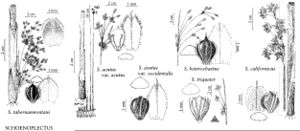Difference between revisions of "Schoenoplectus triqueter"
Verh. K. K. Zool.-Bot. Ges. Wien 38(Sitzungsber.): 49. 1888.
FNA>Volume Importer |
imported>Volume Importer |
||
| (2 intermediate revisions by 2 users not shown) | |||
| Line 8: | Line 8: | ||
}} | }} | ||
|common_names=Triangular club-rush | |common_names=Triangular club-rush | ||
| + | |special_status={{Treatment/ID/Special_status | ||
| + | |code=I | ||
| + | |label=Introduced | ||
| + | }}{{Treatment/ID/Special_status | ||
| + | |code=F | ||
| + | |label=Illustrated | ||
| + | }} | ||
|basionyms={{Treatment/ID/Basionym | |basionyms={{Treatment/ID/Basionym | ||
|name=Scirpus triqueter | |name=Scirpus triqueter | ||
| Line 30: | Line 37: | ||
|elevation=0 m | |elevation=0 m | ||
|distribution=Oreg.;Wash.;Eurasia. | |distribution=Oreg.;Wash.;Eurasia. | ||
| + | |introduced=true | ||
|discussion=<p>In North America <i>Schoenoplectus triqueter</i> is known only from the tidal Columbia River system (B. W. Lightcap and A. E. Schuyler 1984), where it forms fertile hybrids with <i>S. tabernaemontani</i> [S. ×kuekenthalianus (Junge) D. H. Kent = <i>Scirpus</i> ×scheuchzeri Brugg]. Fertile hybrids between the same species also occur in Europe.</p> | |discussion=<p>In North America <i>Schoenoplectus triqueter</i> is known only from the tidal Columbia River system (B. W. Lightcap and A. E. Schuyler 1984), where it forms fertile hybrids with <i>S. tabernaemontani</i> [S. ×kuekenthalianus (Junge) D. H. Kent = <i>Scirpus</i> ×scheuchzeri Brugg]. Fertile hybrids between the same species also occur in Europe.</p> | ||
|tables= | |tables= | ||
| Line 53: | Line 61: | ||
|publication title=Verh. K. K. Zool.-Bot. Ges. Wien | |publication title=Verh. K. K. Zool.-Bot. Ges. Wien | ||
|publication year=1888 | |publication year=1888 | ||
| − | |special status= | + | |special status=Introduced;Illustrated |
| − | |source xml=https:// | + | |source xml=https://bitbucket.org/aafc-mbb/fna-data-curation/src/2e0870ddd59836b60bcf96646a41e87ea5a5943a/coarse_grained_fna_xml/V23/V23_69.xml |
|genus=Schoenoplectus | |genus=Schoenoplectus | ||
|section=Schoenoplectus sect. Schoenoplectus | |section=Schoenoplectus sect. Schoenoplectus | ||
Latest revision as of 21:42, 5 November 2020
Rhizomes 1.5–5 mm diam. Culms sharply trigonous, 0.5–1.5 m × 2–4 mm. Leaves 3–4, basal, smooth; sheath fronts not pinnate-fibrillose; blades 1 or 2, thickly V-shaped in cross section, to equaling sheath length. Inflorescences 1–2 timesbranched or subcapitate or of 1 spikelet, branches to 4 cm; proximal bract usually erect, trigonous, 2–7 cm. Spikelets 1–35, in clusters or solitary, 5–12 × 3–4 mm; scales straw-colored to orange-brown or midrib greenish, usually clearly lineolate-spotted, ovate, 3–3.5 × 2.5 mm, flanks ribless, midrib proximally spinulose, apex acute to rounded, notch 0.3 mm deep, awn 0.3 mm, sparsely spinulose. Flowers: perianth members 4–6, brown, bristlelike, equaling to less than 1/2 of achene body, retrorsely spinulose; anthers 2 mm; crest short, spinulose; styles 2-fid. Achenes brown, biconvex, ovoid to obovoid, 2–2.5 × 1.5–2 mm; beak 0.1–0.2 mm. 2n = 42.
Phenology: Fruiting summer.
Habitat: Freshwater tidal shores, marshes, dredge spoil
Elevation: 0 m
Distribution

Introduced; Oreg., Wash., Eurasia.
Discussion
In North America Schoenoplectus triqueter is known only from the tidal Columbia River system (B. W. Lightcap and A. E. Schuyler 1984), where it forms fertile hybrids with S. tabernaemontani [S. ×kuekenthalianus (Junge) D. H. Kent = Scirpus ×scheuchzeri Brugg]. Fertile hybrids between the same species also occur in Europe.
Selected References
None.
